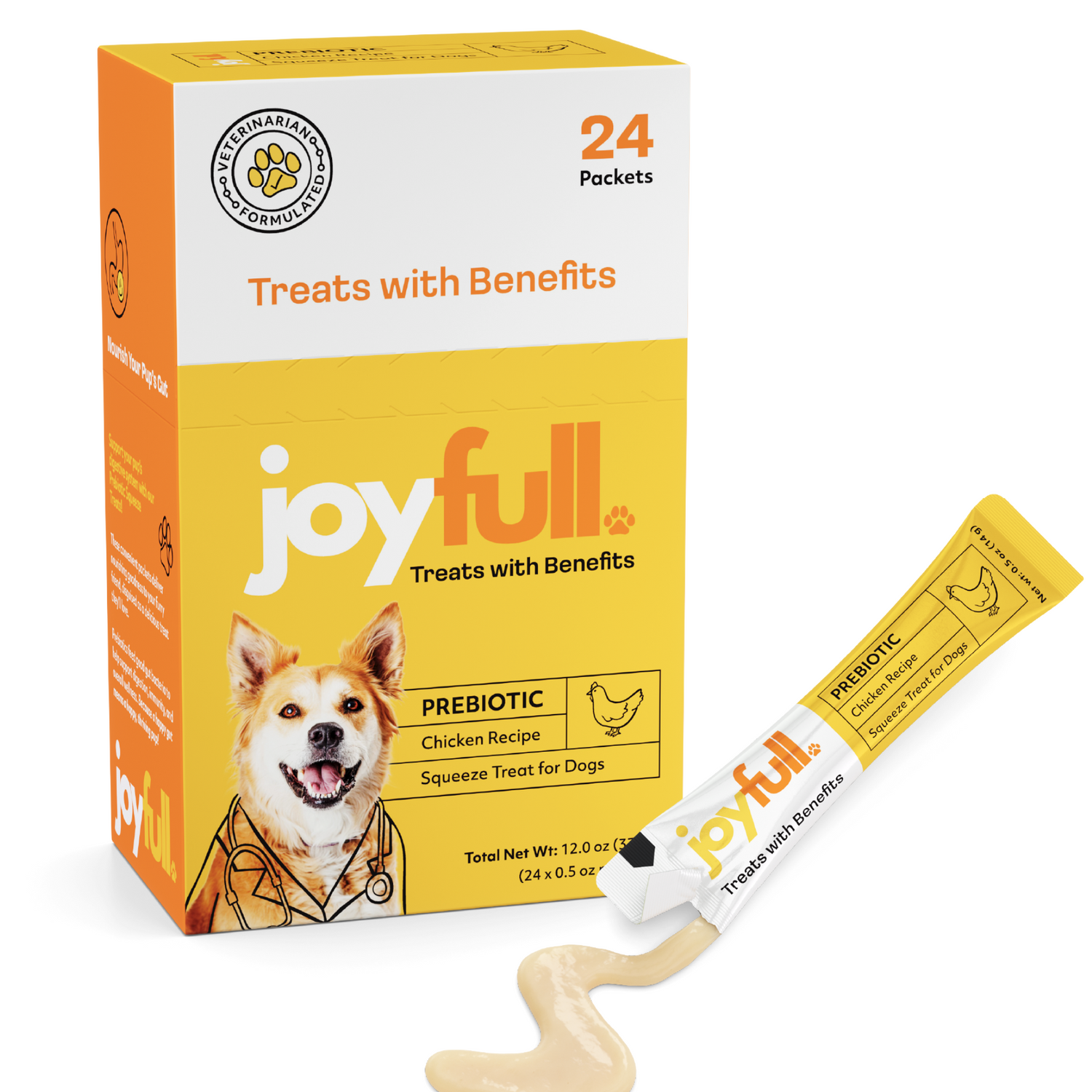
Can Dogs Eat Chia Seeds? Safe Tips & Benefits Explained
So, you're looking at that little jar of chia seeds in your pantry and wondering if you can share them with your four-legged best friend. Good news: yes, dogs can absolutely eat chia seeds! They're not just safe; they can be a fantastic, nutrient-dense addition to their diet.
But there's one crucial catch we need to talk about: preparation is everything. You can't just toss a spoonful of dry seeds into their food bowl and call it a day.
The Short Answer: Yes, but With a Catch
It's tempting to want to share our own healthy superfoods, and in this case, it's a great instinct. When served correctly, chia seeds offer a powerhouse of nutrients that can help your dog maintain a beautiful, shiny coat and support their digestive health.
The "catch" comes down to how these tiny seeds behave with liquid. Chia seeds are incredibly absorbent—they can soak up many times their weight in water. If your dog eats them dry, they can expand in the throat or digestive tract, posing a potential choking hazard or causing serious stomach upset. Soaking them first is a non-negotiable step to keep your pup safe and help them absorb all the good stuff.
To give you a quick rundown right away, here's a simple summary of the most important points. Think of this as your cheat sheet before we dive deeper into the why and how.
Chia Seeds for Dogs At a Glance
| Key Aspect | Summary for Pet Parents |
|---|---|
| Main Benefits | Packed with Omega-3 fatty acids for a healthy coat, high in fiber for good digestion, and a great source of plant-based protein. |
| Potential Risks | Can cause digestive upset (gas, bloating) if you give too much. Dry seeds are a choking hazard, especially for small dogs. |
| Preparation Rule | Always soak the seeds in water until they form a gel. This makes them safe, easy to swallow, and digestible. |
This table covers the essentials, but let's get into the specifics of why these tiny seeds are so beneficial and exactly how to prepare them to unlock their full potential for your dog.
What Exactly Are These Tiny Seeds?
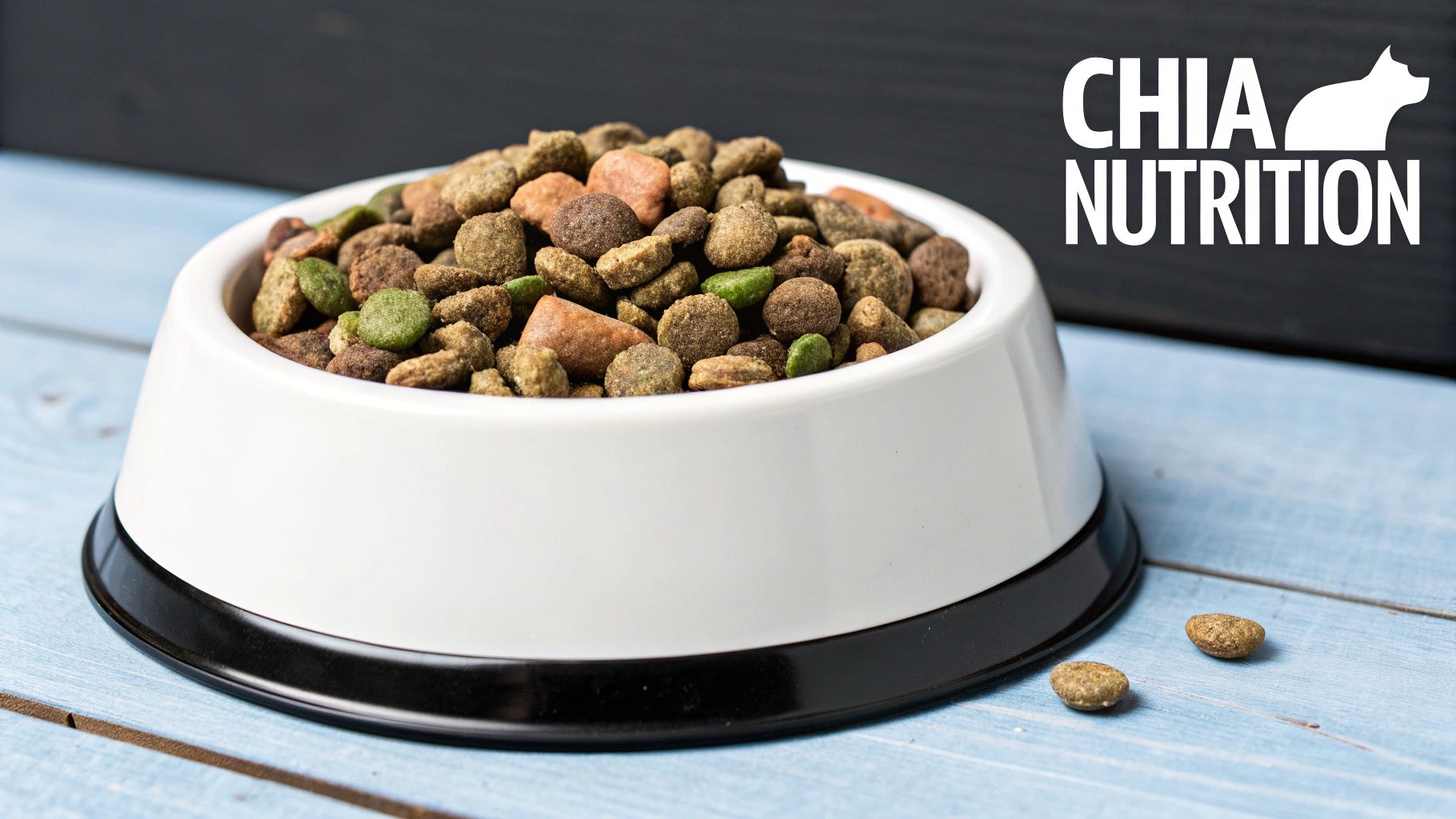
Before we get into the nitty-gritty of health benefits, let's break down what chia seeds actually are. They come from a flowering herb called Salvia hispanica, which, funnily enough, is part of the mint family. While they feel like a modern health craze, their reputation as a nutritional powerhouse is ancient.
Centuries ago, civilizations like the Aztecs and Mayans relied on chia seeds as a core part of their diet. The word "chia" itself is the Mayan word for "strength," which tells you everything you need to know. Warriors would pack them for long marches and battles, using these tiny seeds as a concentrated fuel source.
So, when we consider if our dogs can eat them, we're really asking if this ancient "superfood" has a place in a modern canine's bowl.
Think of Them as Tiny Sponges
The most critical thing to understand about chia seeds is their incredible ability to absorb liquid. Picture each seed as a miniature sponge. When you put them in water, they don't just get damp; they soak up an astonishing amount of liquid—up to 12 times their own weight. This process creates a unique, gel-like coating around each seed.
This "sponge effect" is the key to both their biggest benefits and their potential risks. It's what makes them so hydrating and filling, but it's also why proper preparation is non-negotiable. If you serve them dry, they'll start absorbing fluid and expanding inside your dog's digestive tract, which can be dangerous.
The gel that forms around soaked chia seeds is what makes all the nutrients inside so accessible for your dog's body. Pre-soaking them is the secret to unlocking their benefits safely.
Getting this one concept down is the most important step to feeding your dog chia seeds. It’s the difference between a powerful supplement and a potential problem. It's not just about the nutrients packed inside the seed; it's about how the seed’s physical properties help deliver them.
Now, let's take a closer look at what those nutrients actually are.
Unpacking the Health Benefits for Your Dog
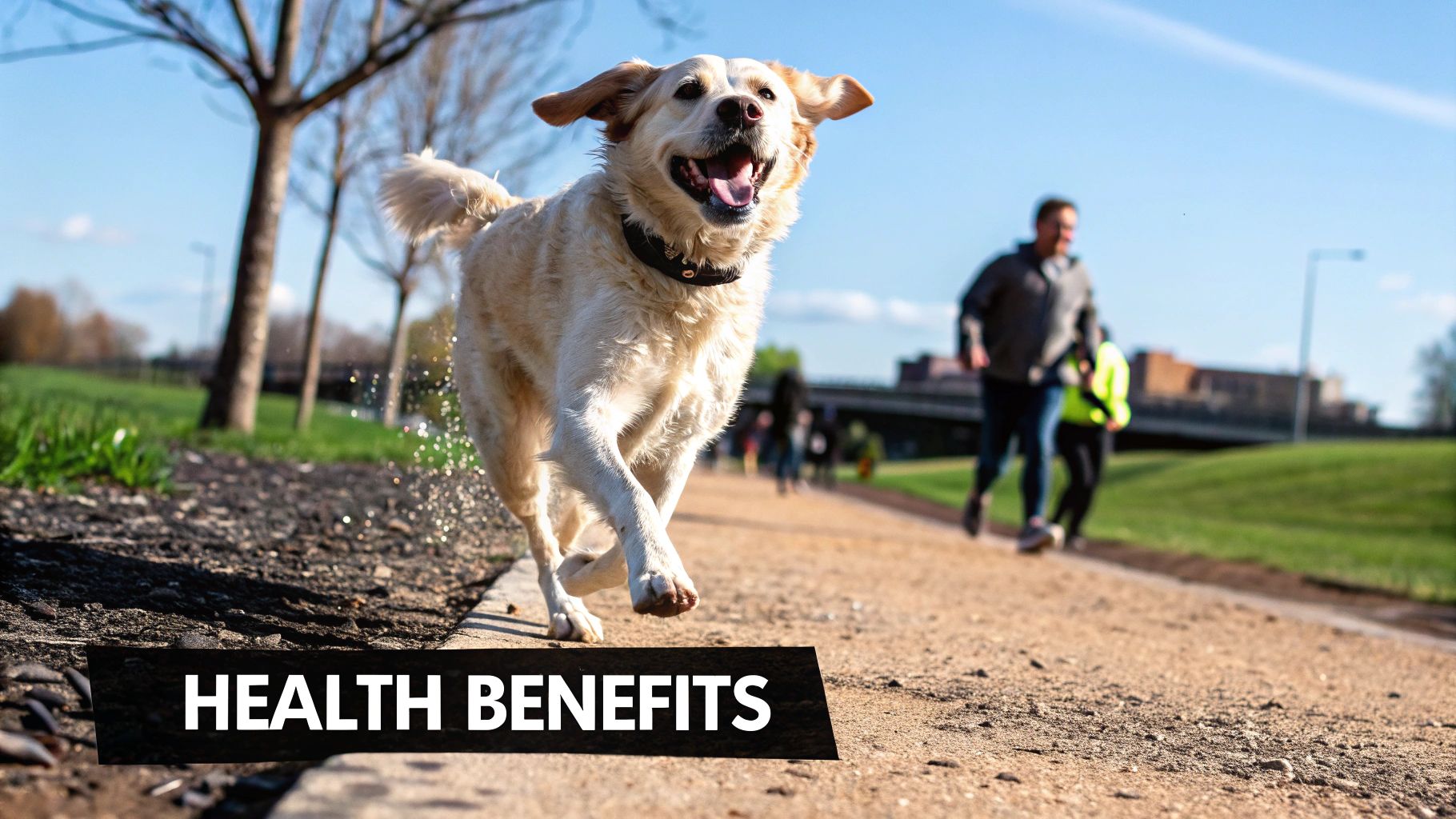
So we know chia seeds are like tiny nutritional sponges. But what happens when you actually add them to your dog's bowl? This isn't just about jumping on a superfood trend; it's about giving them specific, powerful nutrients that can make a real difference, from a shinier coat to a more settled tummy.
The Power of Omega-3 Fatty Acids
One of the standout features of chia seeds is their incredible concentration of omega-3 fatty acids. They're packed with a specific type called alpha-linolenic acid (ALA), which you can think of as an internal moisturizer and lubricant for your dog's entire body.
Just like a good conditioner makes hair soft and shiny, these omega-3s work from the inside out to support a healthy skin barrier and a glossy coat. But their benefits go deeper. Omega-3s also have natural anti-inflammatory properties, which can be a game-changer for older dogs or any pup dealing with stiff joints. They help soothe that discomfort and support better mobility.
As a plant-based source of these essential fats, chia seeds are a fantastic, safe addition for most dogs. Studies have even shown that long-term consumption of chia can increase bone mineral density in animals, proving their benefits are more than just skin deep.
A Boost for Digestive Health
Have you ever noticed how chia seeds form a gel when you soak them? That gel is exactly what makes them so great for your dog's digestive system. They are an amazing source of dietary fiber, particularly soluble fiber.
This gel acts like a gentle regulator for the gut, helping to keep everything moving along smoothly. If your dog sometimes struggles with constipation or, on the flip side, has loose stools, the fiber in chia seeds can help bring things back into balance by adding bulk and absorbing excess water. Exploring the digestive benefits of other fiber-rich foods like psyllium husk can give you a broader perspective on how different fibers support canine gut health.
A neat side effect of that gel is that it helps your dog feel fuller for longer. This can be a really useful tool if you're trying to manage the weight of a dog who seems to be hungry all the time.
More Than Just Fats and Fiber
While the omega-3s and fiber get most of the attention, chia seeds offer a whole lot more. They provide a well-rounded nutritional boost, making them one of the best ingredients for dog food you can add to your pup's diet.
Here's a quick look at what else is packed into these tiny seeds:
- Plant-Based Protein: Chia provides a good source of protein, which is crucial for building and maintaining strong muscles.
- Antioxidants: These little powerhouses help protect your dog's cells from damage, supporting their immune system and promoting healthy aging.
- Essential Minerals: They're loaded with key minerals like calcium and phosphorus for strong bones and teeth, along with magnesium and zinc, which are involved in countless bodily processes.
When you add chia seeds to your dog's bowl, you’re not just giving them a single ingredient. You're giving them a complex blend of nutrients that all work together to support their health and vitality for years to come.
Navigating the Potential Risks and Side Effects
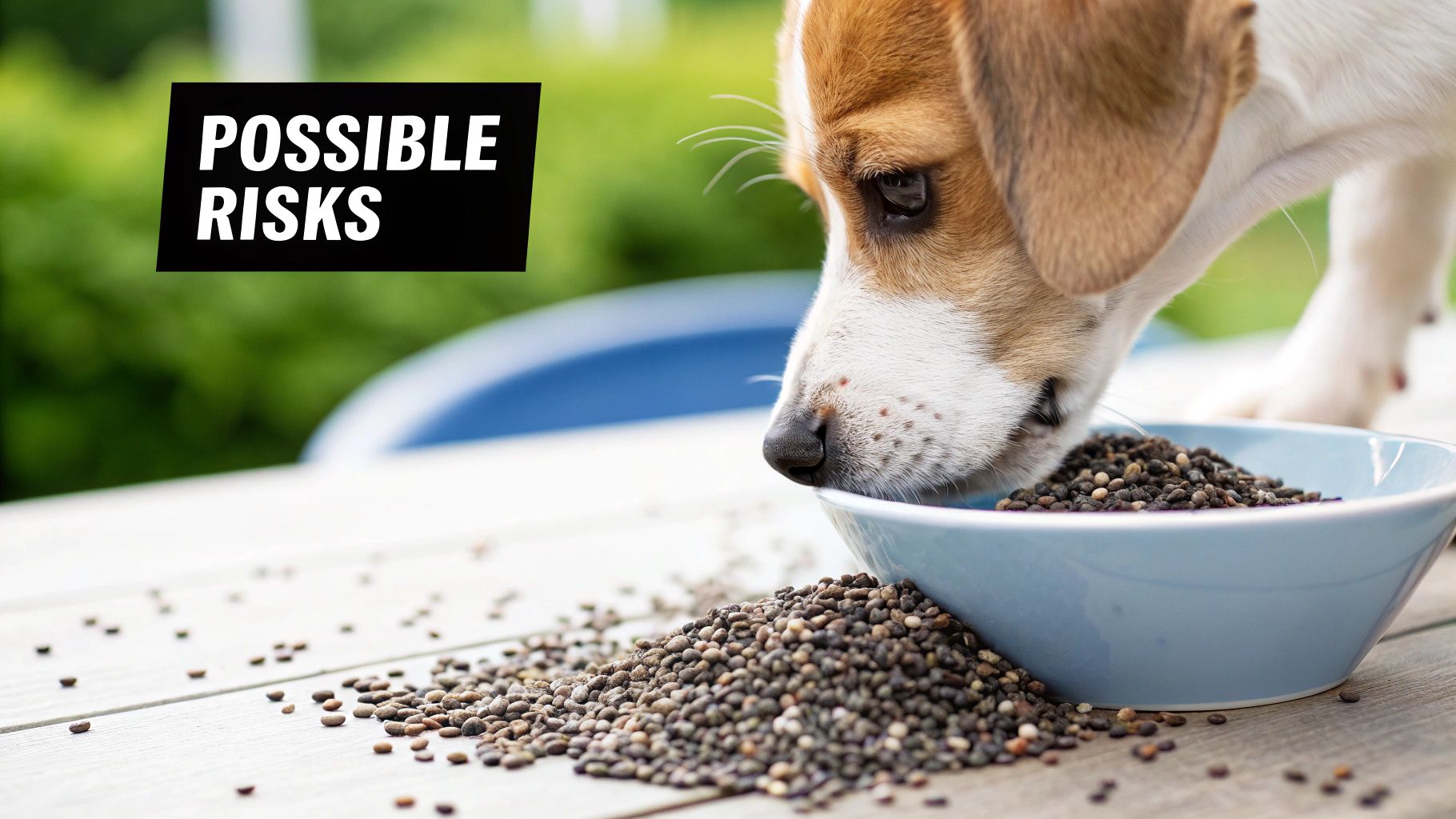
As great as chia seeds are, they aren't a magic bullet for every dog. It's important to know that like any powerful ingredient, they come with a few warnings. Understanding the potential downsides is the key to using them safely so they help, not harm, your best friend.
The main issue comes down to the old "too much of a good thing" problem, especially with fiber. Chia seeds are absolutely loaded with fiber. If you introduce them too quickly or in too large an amount, you can easily overwhelm your dog's digestive system.
This sudden fiber dump can lead to some uncomfortable results. You might see bloating, a lot more gas than usual, or even an upset stomach and diarrhea as their gut tries to figure out what to do. If you're curious about what causes tummy troubles, you can learn more about why your dog might have gas in our detailed guide. The only way to sidestep this is with a slow, gradual introduction.
The Choking Hazard of Dry Seeds
The most immediate physical danger from chia seeds is their superpower: absorbency. Think about how they can soak up 12 times their weight in water. If you give those seeds to your dog dry, they'll start expanding right in their throat or stomach.
This creates a serious choking hazard, especially for small breeds or any dog that tends to inhale their food without much chewing. The dry seeds can quickly clump together, forming a dangerous blockage.
The golden rule of feeding chia seeds is this: never, ever give them to your dog dry. Always soak them in water first until they form that familiar gel. This completely neutralizes the choking risk and makes them safe and easy to swallow.
Proper preparation isn't just a friendly tip—it's the single most important thing you can do to keep your dog safe.
Considerations for Specific Health Conditions
Beyond the basics, some health conditions call for extra caution. While the healthy fats in chia seeds are a bonus for most dogs, they can spell trouble for others.
Dogs with a history of pancreatitis, for example, are incredibly sensitive to high-fat foods. A sudden increase in fat can trigger a painful flare-up. If your dog has ever had pancreatitis or is at risk, you absolutely must talk to your vet before adding any new fats to their diet, including from chia seeds.
Before you start sprinkling, keep these key points in mind:
- Tummy Troubles: Too much fiber too fast can lead to gas, bloating, and diarrhea. Start tiny.
- Choking Risk: Dry seeds are a no-go. They expand with moisture and can cause a blockage. Always soak them first.
- High-Fat Content: If your dog has had pancreatitis or is overweight, get your vet's okay first.
By being mindful of these potential issues, you can make a smart choice and introduce this superfood in a way that’s both safe and beneficial for your pup.
How to Prepare Chia Seeds for Your Dog
So, you know your dog can eat chia seeds, but how you prepare them is what really counts. This is the single most important step to making sure they're a safe and beneficial addition to their diet. You can't just toss a spoonful of dry seeds on top of their kibble.
The golden rule is simple, and it's non-negotiable: always soak them first.
This isn't just a friendly tip—it's a critical safety precaution. When you add liquid to chia seeds, they absorb many times their weight and form a soft, gel-like coating. Think of it like a tiny sponge. This "blooming" process is what makes the seeds easy to swallow and digest.
If you skip this step, those dry seeds can expand in your dog's throat or stomach, creating a serious choking risk or potential for blockage.
Creating the Perfect Chia Gel
Making a batch of chia gel is the absolute best way to serve these tiny powerhouses. It’s incredibly easy and ensures they're fully hydrated and ready for your dog's digestive system.
Here’s all you have to do:
- Measure the Seeds: A good starting point is about ¼ teaspoon of dry seeds for every 10 pounds your dog weighs. This is a daily serving size.
- Add Water: Combine the seeds with water. A ratio of about 1 part seeds to 4 or 5 parts water works great, but you can't really overdo it on the water, so don't stress about being precise.
- Let It Sit: Give it a good stir and let it rest for at least 15-20 minutes. You'll see it transform into a thick, pudding-like gel. You can even make a larger batch and keep it in an airtight container in the fridge for up to a week.
This simple visual guide walks you through the key steps.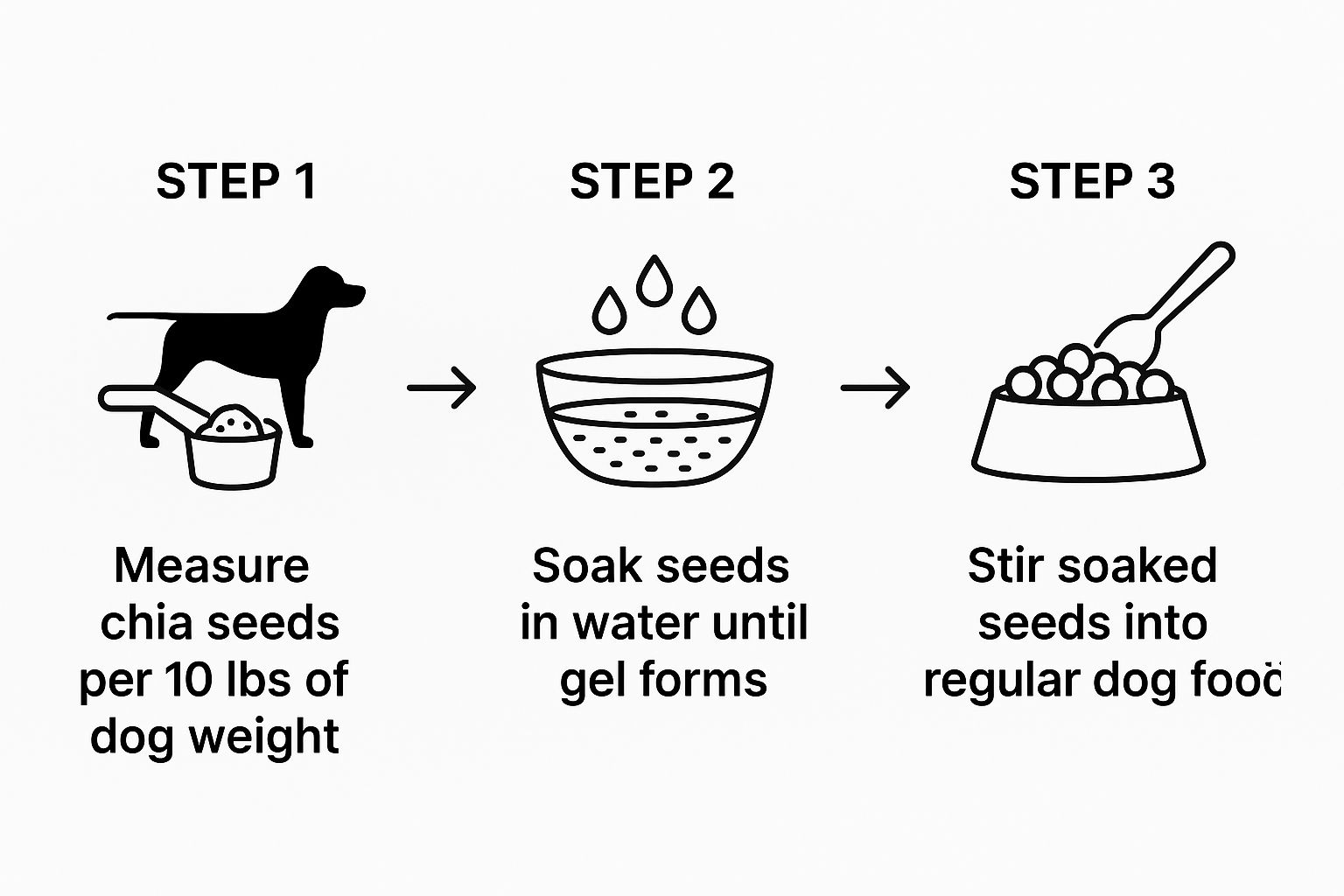
As you can see, it's all about going from careful measuring to proper soaking. That's the secret to unlocking the benefits safely before you add it to their bowl.
Daily Chia Seed Serving Guide for Dogs
To make things even clearer, here’s a handy chart outlining how much to feed your dog based on their size. Remember, these amounts are for dry seeds before you turn them into a gel.
| Dog Size (Weight) | Recommended Daily Amount (Dry Seeds) | Preparation Note |
|---|---|---|
| Extra Small (Under 10 lbs) | Up to ¼ teaspoon | Always mix with water to form a gel first. |
| Small (10-30 lbs) | ¼ to ½ teaspoon | Introduce slowly and ensure it's fully hydrated. |
| Medium (30-50 lbs) | ½ to 1 teaspoon | Mix the prepared gel directly into their food. |
| Large (50-90 lbs) | 1 to 1.5 teaspoons | Perfect for adding to wet or dry meals. |
| Extra Large (Over 90 lbs) | Up to 2 teaspoons | Monitor stool consistency when introducing. |
Always start with a smaller amount than recommended and work your way up over a week or two. This gradual introduction helps their digestive system adapt to the extra fiber without any tummy troubles.
Fun Ways to Serve Chia Gel
Once your chia gel is ready, the fun begins! It’s virtually tasteless, so even the pickiest eaters are unlikely to notice it.
The most crucial takeaway is to start with a very small amount and gradually increase to the recommended serving over a week or two. This gives your dog's digestive system time to adjust to the added fiber.
Here are a few easy ideas to get you started:
- Mix with Meals: The simplest approach is to stir the chia gel right into your dog's regular wet or dry food.
- Boost a Snack: Swirl a spoonful into some plain yogurt (with no xylitol!) or pumpkin puree for a super-powered treat.
- Bake into Goodies: Add the gel to your favorite healthy dog treat recipes. It's a great binder and a sneaky way to add nutrients.
Taking the time to add thoughtful ingredients to your pet's diet is becoming more common. It's a lot like the care people take when making homemade animal feed for other animals—it’s all about quality control and providing the best nutrition. By preparing chia seeds the right way, you're taking a similar, mindful step toward supporting your dog's health.
Why Superfoods for Dogs Are a Growing Trend
If you're wondering whether dogs can eat chia seeds, you're not alone. You're part of a massive, positive shift in how we think about our dogs' health. The days of scooping out the same old kibble without a second thought are long gone.
Today, we see our dogs as true family members. It only makes sense that we'd start looking at their food bowls the same way we look at our own plates, seeking out the best possible nutrition to help them live long, happy lives.
This movement is often called the "humanization" of pet care, and it's all about moving from simply treating sickness to proactively building a foundation of wellness. We're a community of owners dedicated to helping our dogs not just survive, but truly thrive. This very movement has pushed the pet food industry forward, leading to better-quality formulas that highlight natural, plant-based ingredients.
A Global Shift in Pet Nutrition
This isn't just a small, local trend—it's a global one. From the United States and Australia to many parts of Europe, dog owners are actively looking for natural ways to boost their pets' diets.
This is exactly where superfoods like chia seeds come in. They perfectly match the desire for a powerful, plant-based source of nutrients that supports overall health. Of course, as with any new food, a slow and steady approach is best. Experts recommend starting with a very small amount to avoid any digestive upset, as a sudden high-fiber kick can cause loose stools. You can learn more about a safe introduction to chia seeds at Dog Child.
By looking into ingredients like chia, you’re joining a worldwide conversation focused on taking our dogs' nutrition to the next level.
Key Takeaway: The surge in popularity for superfoods like chia seeds shows a huge change in how we view pet ownership. The goal is no longer basic care, but providing our dogs with the same high standard of nutrition we want for ourselves.
Ultimately, this trend gives you the power to make more thoughtful decisions for your dog. But it's important to balance your excitement for new ingredients with expert advice. While trends are fantastic for sparking new ideas, your veterinarian should always have the final say. They are your best partner in navigating these options safely to build the perfect health plan for your best friend.
Answering Your Top Questions About Chia Seeds for Dogs
Alright, let's wrap this up by tackling the questions I hear most often from dog owners. Getting straight answers to these common concerns is the best way to feel confident before you start sprinkling these little seeds into your dog's bowl.
Can Puppies Have Chia Seeds?
Yes, but you need to be extra careful. A puppy's digestive system is still a work in progress and far more sensitive than an adult dog's. While chia seeds aren't toxic, that high fiber content can easily overwhelm a young pup's gut.
If you do decide to give them a try, the amount needs to be minuscule—I'm talking a tiny pinch of pre-soaked seeds, nothing more. Even more importantly, a growing puppy has very specific, finely-tuned nutritional needs. Always, always check with your vet before adding any new food or supplement to their diet to make sure you aren't disrupting their crucial development.
Is There a Difference Between Black and White Seeds?
Nope, not really! From a nutritional standpoint, black and white chia seeds are virtually identical. Both are loaded with the same good stuff—omega-3s, fiber, protein, you name it.
The choice is purely about what's available at your local store or your own preference. So go ahead and grab whichever bag is easiest to find. Your dog will get the same awesome health boost either way.
The Bottom Line: When it comes to your dog, the color of the chia seed is irrelevant. It’s the preparation and the portion size that truly matter for their health and safety.
How Long Does It Take to See Results?
This is where a little patience comes in handy, as the timeline really depends on what benefit you're looking for. Some changes show up faster than others.
- Skin and Coat: You could start seeing a glossier coat and less flaky skin in just a few weeks of consistent feeding.
- Digestion: The fiber gets to work pretty quickly, so you might notice more regular and well-formed poops relatively soon.
- Joint Health: Benefits linked to reducing inflammation and supporting joints are more of a long game. It could take a few months of daily use to see a noticeable difference here.
Can Chia Seeds Help My Dog Lose Weight?
They can certainly be part of the plan, but they aren't a silver bullet for weight loss. The magic is in their high soluble fiber content, which absorbs water and expands in the stomach. This helps your dog feel fuller for longer, which can be a huge help in cutting down on begging between meals.
But here’s the catch: the seeds themselves are dense in calories. You have to be strict with portion control to avoid accidentally sabotaging your dog's diet. Think of chia seeds as a supportive tool within a broader, vet-approved plan that includes a calorie-controlled diet and regular exercise.
At Joyfull, we're all about making your pet's wellness journey simple and effective. We craft our formulas with clean ingredients and high-quality proteins, all backed by veterinary science, because we know your pets deserve nothing less. You can explore our products to learn more.
